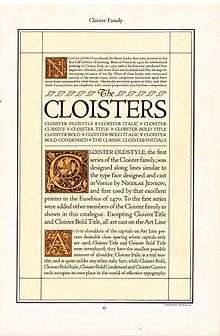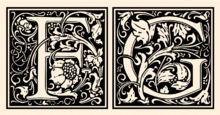Cloister (typeface)
 | |
| Category | Serif |
|---|---|
| Classification | Old-style, Venetian |
| Designer(s) | Morris Fuller Benton |
| Foundry | American Type Founders |
| Date released | 1913 onwards |
| Variations | Cloister Initials |
Cloister is a serif typeface that was designed by Morris Fuller Benton and published by American Type Founders from around 1913.[1] It is loosely based on the printing of Nicolas Jenson in Venice in the 1470s, in what is now called the "old style" of serif fonts.[2] American Type Founders presented it as an attractive but highly usable serif typeface, suitable both for body text and display use.[3]
Metal type release
To ensure its versatility, Cloister was released in a wide selection of sizes and weights. This included swash capitals in italic, an inline style and Cloister Initials, a set of initial capitals by Frederic Goudy to match.[4] The practice of creating a wide range of variants of a successful face was a standard ATF practice in order to capitalise on a successful typeface's popularity and allow coherent layout and graphic design; its 1923 specimen book described its approach of creating families which could allow types to "talk at command with varying emphasis and orchestral power...the client [has] perceived that a catalogue or advertisement set in one type family had more influence...than if its message to the public were confused by a medley of display types."[5]
Unlike many other American Type Founders typefaces, Cloister was cast on the "art line" rather than the standardised "common line" of American metal type used in the period. This meant that it was cast with the area of the typeface above the baseline smaller than normal, so the descenders could be at a long, historically accurate length.[6][lower-alpha 1][5] ATF released a blackletter design under the name of "Cloister Black"; this and a set of Cloister Borders were the first ATF typefaces to use the name, before Cloister Old Style was released.[8][9][lower-alpha 2] Later Cloister was released on hot metal typesetting machines such as that of Linotype, Intertype and Monotype, and additional weights were created for these.
Cloister was somewhat variably named by printers in the metal type period, with "Cloister Old Style", "Cloister Oldstyle", "Cloister Old Face" and "Cloister Oldface" all used to refer to it.[10]
Cloister's release in metal type included:
- Cloister Old Style roman
- Cloister Italic
- Cloister Cursive (swash alternates for the italic)
- Cloister Bold
- Cloister Bold Italic
- Cloister Title (titling capitals, talking up the whole surface area of the metal type with no space for descenders)
- Cloister Bold Title
- Cloister Bold Condensed
- Cloister Lightface (a lighter style)
- Cloister Lightface Italic
- Cloister Cursive Handtooled
Digitisations

A digitisation has been released by P22 and another by URW.[11][12][13] Goudy's Cloister Initials, much esteemed in their own right, have also been digitised by P22 and by Dieter Steffmann.[14][15] Cloister Black has also been digitised separately.[16][17]
See also
References
- ↑ Squitieri, Christina. "Cloister Font Family". Center for Book Arts. Retrieved 29 June 2016.
- ↑ Allan Haley (15 September 1992). Typographic Milestones. John Wiley & Sons. pp. 65–68. ISBN 978-0-471-28894-7.
- ↑ Alexander S. Lawson (January 1990). Anatomy of a Typeface. David R. Godine Publisher. pp. 55–61. ISBN 978-0-87923-333-4.
- ↑ "Cloister Open Face". Linotype. Retrieved 29 June 2016.
- 1 2 Specimen Book & Catalogue. American Type Founders. 1923. pp. 66–81. Retrieved 30 August 2015.
- ↑ "Founders Type Alignments". Happy Dragons Press. Retrieved 29 June 2016.
- 1 2 American Specimen Book of Type Styles. American Type Founders. 1912. pp. 38, 810–11, 1038.
- ↑ "Cloister Black". Fonts in Use. Retrieved 29 June 2016.
- ↑ "Cloister Black CT". MyFonts. CastleType. Retrieved 29 June 2016.
- ↑ Dearden, James (1 February 1977). Encyclopedia of Library and Information Science: Volume 20 - Nigeria: Libraries in to Oregon State University Library. CRC Press. pp. 91–100. ISBN 978-0-8247-2020-9.
- ↑ "LTC Cloister". MyFonts. P22. Retrieved 29 June 2016.
- ↑ "Cloister". MyFonts. URW++. Retrieved 29 June 2016.
- ↑ "Cloister Old Style B EF". MyFonts. Elsner + Flake. Retrieved 29 June 2016.
- ↑ Steffmann, Dieter. "Goudy Initialen". 1001 Fonts. Typographer Mediengestaltung. Retrieved 27 August 2015.
- ↑ "LTC Goudy Initials (more complex Cloister Initials digitisation with negative/positive elements)". MyFonts. LTC. Retrieved 27 August 2015.
- ↑ "Cloister Black". CastleType. Retrieved 29 June 2016.
- ↑ "Cloister Black BT". MyFonts. Bitstream. Retrieved 29 June 2016.
External links
- ATF's 1923 specimen book (their legendary last major specimen before the Depression), showing Cloister on pp. 66–81 (original page numbers).
- Specimen sheet (Intertype specimen)
- ATF 1912 specimen book - shows Cloister Black (pages 810-811) and Cloister Borders (page 1038)